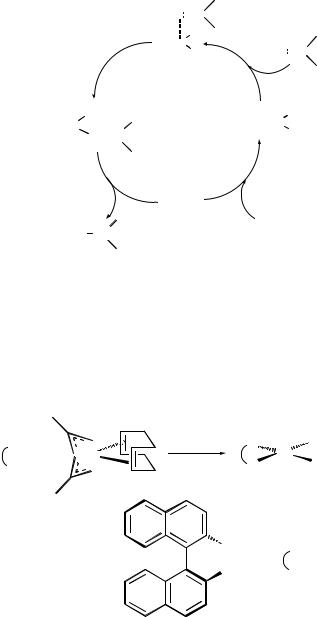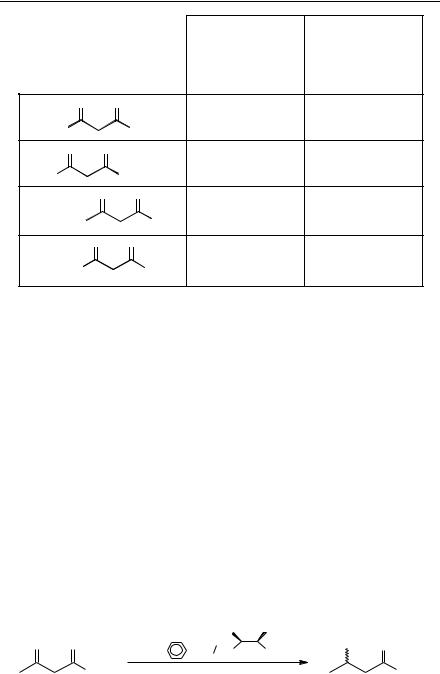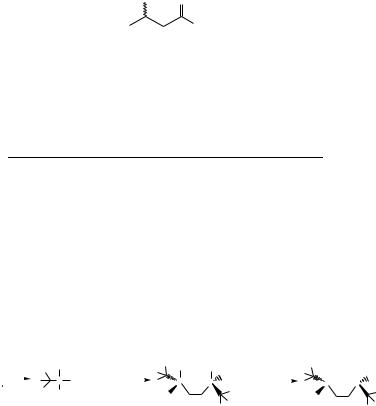

Catalysts for Fine Chemical Synthesis: Hydrolysis, Oxidation and Reduction. Volume 1 Edited by Stan M Roberts and Geraldine Poignant Copyright 2002 John Wiley & Sons, Ltd. ISBN: 0-471-98123-0
9Asymmetric Reduction of Ketones Using Organometallic Catalysts
CONTENTS
9.1 |
Introduction . . . . . . . . . . . . . . . . . . . . |
115 |
|
9.2 |
Asymmetric hydrogenation using a metal catalyst: [Ru((S)-BiNAP)]. . . . |
117 |
|
9.3 |
Asymmetric transfer hydrogenation of b-ketoesters |
|
|
|
Kathelyne Everaere, Jean-FranCË ois Carpentier, AndrE Mortreux and |
|
|
|
|
 |
|
|
Michel Bulliard . . . . . . . . . . . . . . . . . . . |
121 |
|
9.4 |
(S,S)-1,2-bis(tert-butylmethylphosphino)ethane (BisP*): synthesis |
|
|
|
and use as a ligand |
|
|
|
T. Imamoto . . . . . . . . . . . . . . . . . . . . . |
123 |
|
|
9.4.1 |
Synthesis of BiSP* . . . . . . . . . . . . . . . . . . |
123 |
|
9.4.2 Synthesis of 1,2-bis(tert-butylmethylphosphino)ethaneruthenium |
|
|
|
|
bromide (BisP*ÿRu) . . . . . . . . . . . . . . . . . . |
125 |
|
9.4.3 |
Synthesis of (R)-(ÿ)-methyl 3-hydroxypentanoate using (BisP*ÿRu) . . . |
126 |
9.5 |
(1S,3R,4R)-2-Azanorbornylmethanol, an efficient ligand forruthenium- |
|
|
|
catalysed asymmetric transfer hydrogenation of aromatic ketones |
|
|
|
Diego A. Alonso and Pher G. Andersson . . . . . . . . . . . . |
127 |
|
|
9.5.1 |
Synthesis of ethyl(1S,3R,4R)-2-[(S)-1-phenylethylamino]-2-azabicyclo |
|
|
|
[2.2.1]hept-5-ene-3-carboxylate . . . . . . . . . . . . . . . |
129 |
|
9.5.2 |
Synthesis of (1S,3R,4R)-3-hydroxymethyl-2-azabicyclo[2.2.1]heptane . . . |
131 |
|
9.5.3 |
Ruthenium-catalysed asymmetric transfer hydrogenation of acetophenone . |
133 |
References . . . . . . . . . . . . . . . . . . . . . . . |
134 |
||
9.1INTRODUCTION
Asymmetric catalytic reduction reactions represent one of the most efficient and convenient methods to prepare a wide range of enantiomerically pure compounds (i.e. a-amino acids can be prepared from a-enamides, alcohols from ketones and amines from oximes or imines). The chirality transfer can be accomplished by different types of chiral catalysts: metallic catalysts are very efficient for the hydrogenation of olefins, some ketones and oximes, while nonmetallic catalysts provide a complementary method for ketone and oxime hydrogenation.
C |
|
[M]* |
|
H |
||
H2 |
C |
|||||
|
||||||
|
+ |
|
|
|
||
|
|
X |
||||
X |
|
|
||||
|
|
|
|
|
H X= O, NR, CR2 |
|
116 |
hydrolysis, oxidation and reduction |
Enantioselective catalysis using chiral metal complexes provides a flexible method for asymmetric hydrogenation. The metallic elements possess a variety of catalytic activities and their combination with organic ligands or auxiliaries that direct the steric course can give very efficient catalytic complexes. Welldesigned chiral metal complexes can discriminate precisely between enantiotopic groups, or faces, and catalyse the formation of a wide range of natural and unnatural substances with high enantiomeric purity. Asymmetric reduction with a transition metal can use molecular hydrogen (hydrogen gas) as the source of hydrogen or nonhazardous organic molecules as donors of hydrogen such as formic acid or 2-propanol. This last method, hydrogen transfer, can provide a complement to the catalytic reduction using molecular hydrogen[1].
The first enantioselective hydrogenation of unsaturated compounds was using metallic catalysts deposited on chiral supports in the 1930s[2]. In the 1950s, using this method an enantioselectivity exceeding 60 % was obtained[3]. Knowles[4] and Horner[5] in 1968 reported homogeneous asymmetric hydrogenation using rhodium±chiral tertiary phosphine complexes.
Nonmetallic systems (Chapter 11) are efficient for catalytic reduction and are complementary to the metallic catalytic methods. For example lithium aluminium hydride, sodium borohydride and borane±tetrahydrofuran have been modified with enantiomerically pure ligands[6]. Among those catalysts, the chirally modified boron complexes have received increased interest. Several ligands, such as amino alcohols[7], phosphino alcohols[8,9] and hydroxysulfoximines[10], complexed with the borane, have been found to be selective reducing agents.
In 1969, Fiaud and Kagan[11] tested ephedrine boranes but achieved only 3.6±5 % enantiomeric excess in the reduction of acetophenone. Itsuno et al.[12] reported in 1981 an interesting enantioselective reduction of a ketone using an amino alcohol±borane complex as a catalyst. Buono[13] investigated and developed the reactivity of phosphorus compounds as ligands in borane complexes for asymmetric hydrogenation.
Enzyme reductions of carbonyl groups have important applications in the synthesis of chiral compounds (as described in Chapter 10). Dehydrogenases are enzymes that catalyse, for example, the reduction of carbonyl groups; they require co-factors as their co-substrates. Dehydrogenase-catalysed transformations on a practical scale can be performed with purified enzymes or with whole cells, which avoid the use of added expensive co-factors. Bakers' yeast is the whole cell system most often used for the reduction of aldehydes and ketones. Biocatalytic activity can also be used to reduce carbon±carbon double bonds. Since the enzymes for this reduction are not commercially available, the majority of these experiments were performed with bakers' yeast[14].
In summary, the asymmetric hydrogenation of olefins or functionalized ketones catalysed by chiral transition metal complexes is one of the most practical methods for preparing optically active organic compounds. Ruthenium± and rhodium±diphosphine complexes, using molecular hydrogen or hydrogen transfer, are the most common catalysts in this area. The hydrogenation of simple ketones has proved to be difficult with metallic catalysts. However,
asymmetric reduction of ketones |
117 |
asymmetric borane complexes are used as nonmetallic catalysts for the hydrogenation of simple ketones, like acetophenone. They can give the corresponding alcohol in high yield and enantiomeric excess. The use of oxidoreductases contained in bakers' yeast can give good results for reduction of carbonyl and carbon±carbon double bonds.
In contrast to the enantioselective reduction of alkenes or ketones, few catalytic systems have been described for the enantioselective reduction of imines. The nature of the N-substituent and the E/Z-isomerism caused by the carbon±nitrogen double bond of the substrate are important parameters for the control of the enantioselectivity[15]. The enantioselective hydrogenation of
carbon±nitrogen bonds has been reported to occur in the presence of iridium, ruthenium,[1,16,17] titanium,[18±20] zirconium or cobalt[21], with chiral dipho-
sphine ligands. Iridium catalysts have been successfully employed in the hydrogenation of N-arylimines.[22±25] Rhodium catalysts have been used for the reduction of imines and nitrones.[26,27] The employment of chiral auxiliaries
for the activation of borane reagents in carbon±nitrogen double bond reduction has been shown to induce high enantioselectivities. However, it is quite difficult to maintain the high enantiomeric excesses, obtained by using stoichiometric amounts of such auxiliaries, in a catalytic version of the reduction[28]. The substrates which lead to the best results are oxime ethers. The oxazaborolidine derived from valinol is a very efficient chiral auxiliary for oxime ether reduction with borane. The oxazaphospholidine derived from prolinol (developed by Buono et al.) induce enantioselectivity in the reduction of imines[8].
In this chapter and in Chapters 10±12, we will review and validate some methods for asymmetric (transfer) hydrogenation of carbon±oxygen and carbon±carbon double bonds catalysed by non-metallic systems, homogeneous transition metal catalysts and biocatalysts. Reduction of carbon±nitrogen double bond systems will be reported in another volume of this series.
9.2 ASYMMETRIC HYDROGENATION USING A METAL CATALYST: [RU((S)-BiNAP)]
Few catalysts have been found to produce chiral alcohols from a range of ketones with both high levels of absolute stereocontrol and high catalytic efficiencies[29]. Metallic catalysts are generally used for the asymmetric hydrogenation of functionalized ketones. High enantioselectivities (>98 % ee) have been observed in the hydrogenation of a variety of b-keto esters using 2,20- bis(phosphino)-1,10-biaryl (BINAP)-derived catalysts such as ruthenium±
BINAP[30]. For the hydrogenation of simple ketones, nonmetallic catalysts like chiral borane complexes are often preferred (Chapter 11).[31,32] Biocatalytic
reduction with bakers' yeast is used for reduction of ketones such as b-ketoe- sters, b-diketones, a-hydroxy ketones, aliphatic and aromatic ketones[33] (Chapter 10).

118 |
hydrolysis, oxidation and reduction |
The mechanism of a metal-catalysed reduction is believed to proceed as described in Figure 9.1.
|
|
O |
|
C |
|
|
|
|
|
|
|
||||
|
|
|
|
||||
|
|
|
H |
|
|
|
|
|
|
L*nM |
O |
|
C |
||
|
|
|
H |
|
|||
|
|
|
|
||||
H |
|
H |
|||||
L*nM |
L*nM |
||||||
|
H |
||||||
O |
|
CH |
|
|
|
||
|
|
|
|
||||
 L*nM
L*nM
HO CH H2
Figure 9.1 Catalytic cycle for hydrogenation of carbonyl compounds.
The method developed by Noyori using [Ru(BiNAP)Cl2](NEt3) as catalyst requires high temperatures and/or hydrogen pressures (100 atm)[30]. As this method needs a specific set-up for hydrogenation at high pressure, it was not possible for us to validate this procedure. However, GeneÃt reported[34, 35] that the catalyst [Ru(BiNAP)Br2](acetone) can give good results for the hydrogenation of b-ketoesters at atmospheric pressure.
P |
Acetone |
P |
|
Br |
|
Ru |
Ru |
Me2CO |
|||
+ |
P |
||||
P |
HBr, MeOH |
|
Br |
||
|
|
|
|
P(Ph)2 |
P |
|
= |
P(Ph)2 |
P |
S-BiNAP

asymmetric reduction of ketones |
119 |
Materials and equipment
. [Ru(allyl)2(COD)n], 6 mg, 0.019 mmol, 0.02 eq
.(S)-(ÿ)-2,20-Bis(diphenylphosphino)-1,10-binaphthyl [(S)-BiNAP], 21 mg, 0.033 mmol, 0.035 eq
. Anhydrous acetone degassed (nitrogen) for 30 minutes, 30 mL
. Anhydrous methanol degassed (nitrogen) for 30 minutes, 30 mL
As the catalyst is very sensitive to oxygen, the solvents were degassed with nitrogen just before use.
. Hydrobromic acid 48 %, 1.0 mL
. Hydrobromic acid solution 0.6 M prepared by mixing 9 mL of degassed methanol and 1 mL of hydrobromic acid 48 %
. Methyl acetoacetate, 100 mL, 0.93 mmol
Methyl acetoacetate was dried with magnesium sulfate which was activated at 500 8C for 2 hours cooled under vacuum and stored under nitrogen.
. Petroleum ether, ethyl acetate, methanol
. Silica gel 60 (0.063±0.04 mm)
. p-Anisaldehyde
. 50 mL Schlenk tube
. Egg-shape magnetic stirrer bar
. Low-pressure hydrogenation apparatus fitted with a gas burette system to measure the hydrogen consumed[36]
. Rotary evaporator
. Kugelrohr apparatus
O |
O |
|
H OH O |
||||||
|
|
|
|
|
|
RuBr2[(S)-BINAP] |
|
|
|
|
|
|
|
|
OMe |
|
|
|
OMe |
|
|
|
|
|
|
|
|
||
|
|
|
|
|
|
MeOH, H2 |
|||
Procedure
1.A 50 mL Schlenk tube was dried overnight in a oven at 150 8C, cooled under vacuum and flushed with nitrogen.
2.The Schlenk tube was filled with [Ru(allyl)2(COD)n] (6 mg), ((S)-BiNAP) (21 mg) and purged twice using vacuum/nitrogen cycles. Anhydrous acetone was added (2 mL) to give a white suspension. The solution was stirred for 30 minutes at room temperature.
3.To this suspension was added a solution of HBr (0.6 M, 0.11 mL). The suspension was stirred for 30 minutes at room temperature. After 15 minutes a yellow precipitate appeared.
4.The solvent was removed by evaporation under high vacuum over 3 hours to give a yellow powder, which was used as the catalyst without any further purification.
120 |
hydrolysis, oxidation and reduction |
5.The Schlenk tube containing the catalyst was filled with degassed methanol (20 mL) and methyl acetoacetate (100 mL); the brown suspension was placed under nitrogen.
6.The Schlenk tube was connected to a low-pressure hydrogenation apparatus fitted with a gas burette system to measure the hydrogen consumed. The Schlenk tube was flushed through three cycles (reduced pressure/ hydrogen) and then placed under an atmospheric pressure of hydrogen. The burette was filled with 200 mL of hydrogen.
Never allow naked flames in the vicinity when hydrogen is being used. Avoid the formation of air±hydrogen mixtures. Any electrical apparatus in the vicinity must be spark-proof. It is far better for the apparatus to be kept in a separate room specially designed for hydrogenations.
7.The solution was vigorously stirred to increase the contact area of the reactants with the hydrogen atmosphere. The solution became lighter brown. The reaction was stopped after 48 hours (no more hydrogen was consumed), by removing the hydrogen using reduced pressure.
8.The reaction was monitored by TLC (eluent: petroleum ether±ethyl acetate; 75:25). The methyl acetoacetate was UV active, stained yellow with p- anisaldehyde, Rf 0.5. No starting material remained after 48 hours.
9.The solution was filtered through a pad of silica gel to remove the catalyst and the filter residue was washed with methanol. The solvent was removed under reduced pressure using a rotary evaporator (water bath at 30 8C) to give a slightly brown oil.
10.The residue was distilled with a Kugelrohr apparatus under water aspirator
vacuum (approximately 20 mbar, 140 8C) to give (S)-methyl-(3)-hydroxy- butanoate (105 mg, 99 %).
The ee (>98 %) was determined by chiral GC (Lipodex1 E, 25 m, 0.25 mm ID, temperatures: column 90 8C isotherm, injector 250 8C, detector 250 8C, mobile phase helium). Rt (R)-enantiomer: 13.5 min; Rt (S)-enantio- mer: 15.2 min.
1H NMR (200 MHz, CDCl3): d 4.22 (m, 1H, CHOH); 3.72 (s, 3H, OCH3); 2.56 (br s, 1H, OH); 2.46 (d, J 6.3 Hz, 2H, CH2); 1.23 (d, J 6.1 Hz, 3H, CH3CHOH).
Mass: calculated for C5H10O3: m/z 118.06299, found [M]‡ 118.06286.
Conclusion
Hydrogenation with Noyori's catalyst required a customized rig for hydrogenation at high pressure to give good results for a large range of substrates. The GeneÃt modification does not require pressure and the catalyst can be prepared in situ which made the reaction very easy to carry out. Table 9.1 gives examples of the different substrates which can be hydrogenated by Noyori's[37] and GeneÃt's methods[35].

asymmetric reduction of ketones |
121 |
Table 9.1 Asymmetric hydrogenation of b-keto esters using [Ru(BiNAP)] complexes (results according to the relevant publications).
|
|
[RuCl2((R)- |
[RuBr2((S)- |
|
|
BINAP)][37] |
BINAP)][35] |
|
|
70 to 100 atm. of H2 |
1 atm. of H2 |
|
|
Yield %, ee % |
Yield %, ee % |
O |
|
O |
|
|
|
>99, >99 |
99, >98* |
H3C |
|
OCH3 |
|
O |
O |
|
|
|
|
99, 99 |
_ |
H3C |
|
OCH2CH3 |
|
|
O |
O |
|
|
|
n=3; 99, 98 |
n=1; 100, 99 |
CH3-(CH2)n |
|
OCH3 |
n=14; 100, 96 |
|
O |
O |
|
|
|
99, >99 |
100, 97 |
(CH3)2HC |
|
OCH3 |
|
* Rection validated
Alternatively, bis(phospholane) ligands can be very effective for the hydrogenation of carbonyl groups. Using a hydrogen pressure of only 60 psi, the hydrogenation of b-ketoesters by [Ru((R,R)±iPr-BPE)Br2] (0.2 mol%) gives
high catalytic efficiency (100 % conversion, 99 % enantiomeric excess) according to the literature[38]. This procedure (not validated in this volume) is similar to the
one described later in this chapter for the hydrogenation of olefins using [(COD)Rh(Me-DuPHOS)] and [(COD)Rh(Me-BPE)] catalysts.
9.3 ASYMMETRIC TRANSFER HYDROGENATION OF b-KETOESTERS
a |
Jean-FranCË ois Carpentier, |
a |
 |
a |
and Michel |
Kathelyne Everaere, |
|
AndrE Mortreux |
|
||
Bulliardb |
|
|
|
|
|
aLaboratoire de Catalyse, B.P. 108, 59652 Villeneuve d'Ascq Cedex, France. bPPG-SIPSY, Z.I. La Croix Cadeau, B.P. 79, 49242 Avrille Cedex, France.
|
|
|
Ph |
CH3 |
O |
O |
[RuCl2( |
)]2 HO |
OH O |
|
|
NHCH3 |
||
|
|
OtBu |
iPrOH, iPrOK |
OtBu |

122 hydrolysis, oxidation and reduction
Materials and equipment
. Anhydrous 2-propanol, 19 mL
. tert-Butyl acetoacetate (98 %), 316 mg, 2 mmol
. di-m-Chlorobis[(benzene)chlororuthenium (II)], 5 mg, 0.01 mmol*
. (1S,2R)-(‡)-Ephedrine, 6.6 mg 0.04 mmol
. Potassium 2-propylate solution, 0.12 mol.Lÿ1
. Ethyl acetate, distilled water
. Hydrochloric acid
. Sodium chloride
. Magnesium sulfate
. Two Schlenk tubes
. Magnetic stirrer plate
. Oil bath
. Vacuum line
Procedure
1. In a Schlenk tube equipped with a magnetic stirrer bar were placed under nitrogen [Ru(benzene)Cl2]2 (5 mg), ephedrine (6.6 mg) and dry 2-propanol (5 mL) previously degassed by three freeze±thaw cycles. The mixture was stirred for 20 minutes at 80 8C to give an orange solution which was allowed to cool to room temperature.
2.In a second Schlenk tube were placed under nitrogen tert-butyl acetoacetate and dry 2-propanol (14 mL). The mixture was degassed and added to the
first solution. Finally, degassed potassium 2-propylate solution (1 mL) was added. The resulting orange solution was stirred at room temperature.
3. The reaction was monitored by GLC (BPX5 25 m 0.32 mm column,
0.8bar N2, 60 8C).
4.After completion of the reaction (1 hour), the solution was neutralized with dilute hydrochloric acid and the solvent removed in vacuo. The residue was diluted with ethyl acetate and the organic solution was washed with saturated aqueous sodium chloride. The organic layer was dried over magnesium sulfate, concentrated under reduced pressure and distilled to afford tertbutyl 3-hydroxybutyrate (80 %).
The ee (44 % in the S enantiomer) was determined by GLC (CHIRASILDEX CB 25 m 0.25 mm column, 0.8 bar H2, 85 8C); (S)-enantiomer: Rt
11.7min, (R)-enantiomer: Rt 12.1 min.
1H NMR (300 MHz, CDCl3): d (ppm) 4.02 (m, J 6 Hz, 1H, CH(OH)); 3.5 (s, 1H, OH), 2.2 (d, J 6 Hz, 2H, CH2); 1.35 (s, 9H, C(CH3)3); 1.09 (d, J 6 Hz,
3H, CH3).
13C NMR (300 MHz, CDCl3): d (ppm) 172.1 (COO); 80.9 (C(CH3)3);
64.2(CH(OH)); 43.9 (CH2); 27.9 (C(CH3)3); 22.3 (CH3).i
* M. Bennett, A. Smith, J. Chem. Soc., Dalton Trans. 1974, 233.

asymmetric reduction of ketones |
123 |
Conclusion
This procedure offers a simple alternative for the reduction of b-ketoesters which does not require the use of an autoclave or hydrogen. The reaction is easily reproducible and leads to virtually quantitative yields of b-hydroxyesters under mild conditions. The use of sterically hindered esters, i.e. iso-propyl or tert-butyl b-ketoesters, significantly improves the catalytic activity, so that reactions go to completion in a reasonable time at room temperature (see below). When the reaction time is too long, transesterification may occur, giving rise to a mixture of an alkyl b-hydroxyester and the corresponding iso-propyl b- hydroxyester. Ephedrine as a chiral ligand affords modest to good enantiomeric excesses according to the nature of the b-ketoester but is essential for good activity of the catalytic system.
|
|
|
OH |
O |
|
|
|
|
R1 |
|
OR2 |
|
|
|
|
|
|
|
|
|
R1 |
R2 |
T(8C) |
t (h) |
GLC Yield (%) |
ee (%) |
|
Me |
Et |
20 |
10 |
100 |
39 |
(S) |
Me |
iPr |
20 |
4 |
100 |
40 |
(S) |
Me |
tBu |
20 |
1 |
100 |
44 |
(S) |
Ph |
Et |
50 |
2.5 |
99 |
40 |
(S) |
Ph |
Et |
50 |
15 |
85 |
94 |
(S)* |
*Catalyst Precursor ˆ [Ru(p-cymene)Cl2]2
9.4 (S,S)-1,2-BIS(TERT-BUTYLMETHYLPHOSPHINO)ETHANE
(BisP*)[39]: SYNTHESIS AND USE AS A LIGAND
T. Imamoto
Department of Chemistry, Faculty of Science, Chiba University, Yayoi-cho, Inage-ku Chiba 263±8522, Japan, Phone & Fax: 81±43±290±2791, e-mail: imamoto@scichem.s. chiba-u.ac.jp
9.4.1SYNTHESIS OF BisP*
|
1) tert-BuMgCl |
|
|
1) sec-BuLi, |
|
|
|
|
|
||||
|
BH3 |
(-)-Sparteine |
|
|
|
|
|
||||||
|
2) MeMgCl |
2) CuCl2 |
BH3 |
BH3 |
CF |
COOH |
|
||||||
|
|
|
|
Me |
Me |
||||||||
PCl3 |
|
|
|
P |
Me |
|
P |
3 |
|
|
|||
3) BH3 |
THF |
|
P |
|
|
P |
P |
||||||
|
|
|
|||||||||||
|
Me |
|
|
Me |
|
|
|
Me |
|
||||
|
|
|
|
|
|
|
|
|
|
||||
|
|
|
|
|
|
|
2 |
|
|
|
|||
|
|
|
|
1 |
|
|
|
|
|
|
|
BisP* |
|
|
|
|
|
|
|
|
|
|
|
|
|
||
Materials and equipment
. Phosphorus trichloride, 6.4 g
. Dry tetrahydrofuran, 20 mL
124 hydrolysis, oxidation and reduction
. tert-Butylmagnesium chloride, 1.0 M THF solution, 52 mL
. Methylmagnesium chloride, 1.0 M THF solution, 112 mL
. Borane±THF complex, 1.0 M, 70 mL
. Hydrochloric acid
. Sodium chloride, sodium sulfate
. Silica gel
. n-Hexane, ethyl acetate, diethyl ether, toluene, ethyl alcohol
. (ÿ)-Sparteine, 8.7 g
. sec-BuLi 1 M in cyclohexane, 37.1 mL
. Copper(II) chloride, 6.2 g
. Aqueous ammonia
. Trifluoromethanesulfonic acid
. Potassium hydroxide
. Basic alumina
. Argon
. Magnetic stirrer
. 300 mL Round-bottomed flask with a magnetic stirrer bar
. Dropping funnel
. Separatory funnel
. Dry ice
. Schlenk tube
. Oil bath
. Rotary evaporator
. Cannula
Procedure |
|
|
1. To a solution of phosphorus trichloride |
(6.4 g) |
in dry tetrahydrofuran |
(20 mL) was added tert-butylmagnesium |
chloride |
(1.0 M THF solution, |
52 mL) at ÿ788C under an argon atmosphere over a period of 2 hours.
2.After stirring at room temperature for 1 hour, methylmagnesium chloride (1.0 M THF solution, 112 mL) was added at 0 8C over 30 minutes. The reaction mixture was stirred at room temperature for 1 hour. To this solution, borane±THF complex (1.0 M, 70 mL) was added at 0 8C, and the mixture was stirred at the same temperature for 1 hour.
3.The reaction mixture was poured into cold 5 % hydrochloric acid (200 mL). The organic layer was separated and aqueous layer was extracted with ethyl acetate (3 80 mL). The combined extracts were washed with brine, dried over sodium sulfate, and concentrated in vacuo.
4.The residual pasty solid was purified by column chromatography over silica gel (n-hexane : ethyl acetate ˆ 8:1) to afford tert-butyl (dimethyl)phosphine± borane (1) 5.29 g (86 %) as white crystals.
5.To a solution of (ÿ)-sparteine (8.7 g) in diethyl ether (dry, 100 mL) secbutyllithium (1 M in cyclohexane, 37.1 mL) was added at ÿ78 8C under an
